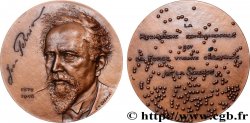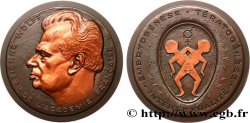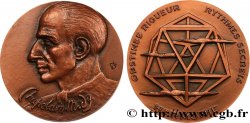fme_602891 - SCIENCES & SCIENTIFIQUES Médaille, Georges Friedmann, n°14
90.00 €约 742.50 CNY
数量
加入购物车

种类 Médaille, Georges Friedmann, n°14
日期: 1977
铸币厂名称/城市 Monnaie de Paris
铸币数量 100
材质 copper
直径 77,5 mm
模子方针 12 h.
重量 167,6 g.
侧面 lisse + 1977 + corne CUIVRE + N°14/100
印模 corne CUIVRE
关于品相的说明
Patine bicolore, noire dans les champs et cuivreuse sur les hauts reliefs. Concrétions vertes au revers
正面
正面的文字 GEORGES / FRIEDMANN.
正面的说明书 Légende verticale de part et d’autre du visage du personnage. Signé : REVOL / 1976.
背面
背面的文字 L’HOMME / DE - DEMAIN / DEVRA / AU / LIEU / DE LEUR / ÊTRE - ASSERVI / SE SERVIR DE SES / OEUVRES TECHNIQUES / POUR SE LIBÉRER / S’ÉPANOUIR.
背面的说明书 Légende en 11 lignes autour d’un corps masculin nu.
评论
Il s’agit du 14e exemplaire sur une édition de 100 médailles.
Georges Friedmann (1902-1977) fut le fondateur d’une sociologie du travail humaniste. Après des études en chimie industrielle, il entra à l’École normale supérieure en 1923. Il consacra la plus grande partie de ses travaux à l'étude des relations de l'homme avec la machine dans les sociétés industrielles de la première moitié du XXe siècle.
This is the 14th medal in an edition of 100. Georges Friedmann (1902-1977) was the founder of a humanist sociology of work. After studying industrial chemistry, he entered the École Normale Supérieure in 1923. He devoted most of his work to the study of the relationship between man and machine in industrial societies in the first half of the 20th century.
Georges Friedmann (1902-1977) fut le fondateur d’une sociologie du travail humaniste. Après des études en chimie industrielle, il entra à l’École normale supérieure en 1923. Il consacra la plus grande partie de ses travaux à l'étude des relations de l'homme avec la machine dans les sociétés industrielles de la première moitié du XXe siècle.
This is the 14th medal in an edition of 100. Georges Friedmann (1902-1977) was the founder of a humanist sociology of work. After studying industrial chemistry, he entered the École Normale Supérieure in 1923. He devoted most of his work to the study of the relationship between man and machine in industrial societies in the first half of the 20th century.








 对产品描述纠错
对产品描述纠错 打印
打印 分享我的选择
分享我的选择 提问
提问 Consign / sell
Consign / sell
 产品介绍
产品介绍










